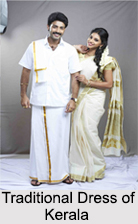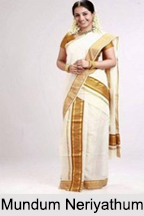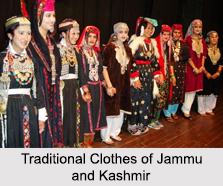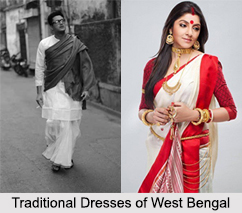 The state of Kerala is known for its backwaters and green charming landscapes. It exudes a sense of calmness and purity which comes more to the forefront when one sees the people of the state clad in all white attires. Dressed in soft colours, the traditional dress of Kerala is Mundu, which is basically a unisex clothing worn as a lower garment. It resembles a long skirt or dhoti and the upper garment varies with age and gender.
The state of Kerala is known for its backwaters and green charming landscapes. It exudes a sense of calmness and purity which comes more to the forefront when one sees the people of the state clad in all white attires. Dressed in soft colours, the traditional dress of Kerala is Mundu, which is basically a unisex clothing worn as a lower garment. It resembles a long skirt or dhoti and the upper garment varies with age and gender.
Traditional Dress of Kerala for Women
The traditional garment worn by the women of Kerala is the Mundum Neriyathum. The conventional piece is the Mundu which is the lower garment and it consists of 2 cotton cloth pieces. The Mundu is worn around the hips and beneath the navel. The cloth is creamy or white in colour and possesses a coloured strip called border or Kara. The women of Kerala wear Mundu in different style from that of the women of Christian origin.  The Neriyathum is the name of the upper garment which is put over the blouse having one of its ends tucked in the Mundu and the other long end worn over the front torso. This is worn in a diagonal way, from the right hips to the left shoulder looking like a saree. The colour of the blouse indicates the marital status and age of the women. Unmarried young Malayali girls take on green blouse whereas the married ones wear red. For festive occasions there are Kasavu Mundu and Kasavu Neryathu, which are extremely delicate pure cotton handloom fabric, bordered with gleaming golden thread. The glossy golden borders are sometimes paired with contrasting bright colours. They are known by the name of Kasavu Saree and are worn as a traditional dress of Kerala.
The Neriyathum is the name of the upper garment which is put over the blouse having one of its ends tucked in the Mundu and the other long end worn over the front torso. This is worn in a diagonal way, from the right hips to the left shoulder looking like a saree. The colour of the blouse indicates the marital status and age of the women. Unmarried young Malayali girls take on green blouse whereas the married ones wear red. For festive occasions there are Kasavu Mundu and Kasavu Neryathu, which are extremely delicate pure cotton handloom fabric, bordered with gleaming golden thread. The glossy golden borders are sometimes paired with contrasting bright colours. They are known by the name of Kasavu Saree and are worn as a traditional dress of Kerala.
Traditional Dress of Kerala for Men
Malayali men are more conservative than the women and their traditional attire is also Mundu, which they wear as a long cloth tucked at the waist and reaches to the ankle. Many men wear no garment above the waist, but those who belong to the higher castes at least drape a towel-like cloth over the shoulders. The traditional wear of the Hindu men residing in the state of Kerala is Kasavu Mundu. This dress is very much popular in the rural or remote areas. This attire is a piece of cloth made of cotton, 3 to 4 meter long having a silk border. The men also wear lungi or kaily, which acts as an informal dress. But while stepping out of the house, the men put on a shirt and wrap a Mundu around their waist. And carry the Neriyathum over their shoulder and apply a paste of sandal on their chest and brows which provides them with a much dignified appearance and a royal look.





















